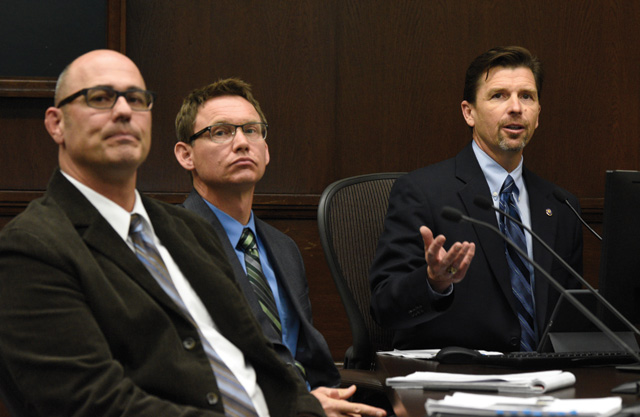Caltrans Slammed for 101 Widening Report
City Officials Say Agency Grossly Minimized Project's Negative Impacts

Some councilmembers daintily called it “robust,” but the letter Santa Barbara traffic planners sent to their counterparts with Caltrans was more like a roundhouse kick to the Adam’s apple. This Tuesday evening, the Santa Barbara City Council voted 6-0 to make that letter their “official opinion” about the latest environmental analysis of the increased congestion the proposed Highway 101 widening will inflict on city streets and intersections.
In a blistering, 23-page critique, Santa Barbara traffic planners — led by Rob Dayton — blasted the supplemental environmental report ordered last year by Judge Thomas Anderle, charging it understates the actual impact to the city. Dayton stated that Caltrans developed a brand-new “threshold of significance” to measure the impact, which, he complained, is 10 times less sensitive than the threshold customarily used by city traffic engineers.
“The problems created by Caltrans’s approach are neither trivial nor academic,” Dayton wrote. The Milpas Street intersections, he said, will experience a 40-48 percent increase in peak-hour traffic as a result of the freeway widening. Northbound morning drivers seeking to get off at Olive Mill Road will find themselves “queuing down the northbound off ramp and blocking the number three travel lane [of the freeway,]” he wrote. “This will present serious safety risks to drivers.”
Had Caltrans used the threshold of significance deployed by city planners, Dayton said congestion at no fewer than nine city intersections would have exceeded what’s deemed “significant” for purposes of environmental review. That’s three times the number identified by Caltrans. And, Dayton added, that number could be even higher when city traffic planners finish crunching the numbers.
The word “significant” is highly charged when used in environmental documents. By law, developers must strive to reduce all impacts to levels below “significant.” Failing that, they must attempt to either mitigate them or find alternatives. Only after those efforts have been unsuccessfully exhausted are decision makers allowed to make “findings of overriding consideration.” Critics of the 101-widening proposal complained that no such analysis was attempted in the first iteration of the environmental review, prompting attorney Mark Chytilo to file a lawsuit attacking the adequacy of the environmental analysis.
Dayton also accused Caltrans of “proposing solutions that they have not shown to be effective.” He complained that Caltrans was not offering to foot its fair share of the bill for three major parallel projects designed to ameliorate some of these impacts. Those three projects combined are estimated to cost $45 million; the most expensive — a roundabout and bridge widening by the Andrée Clark Bird Refuge at Los Patos and Cabrillo Boulevard — is expected to cost $20 million. “Caltrans is proposing something over $460,000 in mitigation for work the city estimates will cost as much as $20 million,” Dayton said.
Marjorie Kirn, the new executive director of S.B. County Association of Governments (SBCAG), argued the council should pursue the parallel projects but not slow the freeway widening down. Delays, she stated, cost $1.4 million a month. With SBCAG about $150 million shy of what the freeway widening will cost, President Donald Trump’s promise to spend a trillion bucks on infrastructure looks promising. Kirn said such funding will go to “shovel ready” projects and urged the council to help make the widening “shovel ready.”
Caltrans’s Scott Eades testified that Caltrans had to create a new threshold of significance that could be applied not just in Santa Barbara but along the entire 101 corridor. He acknowledged that the threshold Caltrans developed had not been used before. Eades also admitted that many traffic statistics included in his environmental report were factually incorrect — as Dayton contended — and pledged to correct them. He called that “very unfortunate.”
Councilmember Cathy Murillo asked Eades whether he’d ever been on the receiving end of so “robust” a letter from other cities and whether Santa Barbara had a reputation for being “difficult.” Eades — diplomatic and professional — demurred. “The City of Santa Barbara is always higher in terms of its level of expectations than other cities in the state,” he said. The deadline to comment on the revised environmental document is January 31. The final report will be released this spring.



